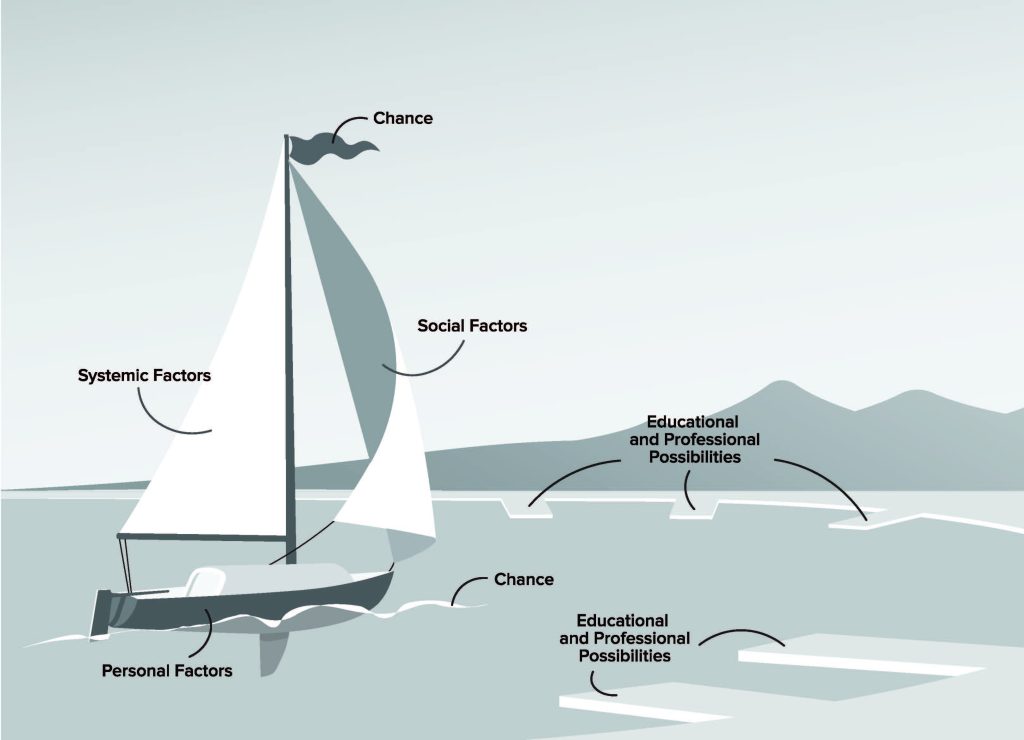|
Getting your Trinity Audio player ready...
|
In today’s fast-paced and ever-evolving job market, navigating a career can feel like sailing through uncharted waters. The Career Sailboat Model (CSM), developed by Korkut-Owen et al., (2014; 2023), offers a fresh perspective on career decision making, likening it to a journey across the seas. This model emphasizes the interplay of various factors that influence our career paths, making it an essential guide for anyone looking to steer their career in the right direction (Figure 1).
In this model, individual/personal factors that determine the direction of a career journey, such as interests, skills and values, are symbolized by the hull of the career sailboat. The main sail symbolizes political, economic and legal-related factors, including economic structures, laws and job opportunities. Social factors are represented by the front sails, with family characteristics, cultural realities and media serving as illustrative examples. The effect of wind, currents and waves – essential for moving the sailboat – symbolizes chance, with health conditions, natural events, and unforeseen positive or negative occurrences being just a few possible examples.
In CSM, every factor is defined as a substantial construct for the voyage of a sailboat, because these factors are interrelated (Korkut-Owen et al., 2014; 2023). CSM uses the entire career counselling process, including self-knowledge, recognition of educational/professional possibilities and decision/career planning.
The model easily permits the use of informal/qualitative assessment tools by career counsellors because it emphasizes clients’ narratives, lived experiences and meaning-making processes rather than relying solely on standardized test results. The model’s components – such as the “wind” of chance events or the “rudder” of beliefs and values – invite open-ended exploration through tools like life-role interviews, career lifelines and story-based reflections. These approaches align naturally with the model’s holistic and metaphor-based structure, making it especially adaptable for diverse clients, including those whose stories do not fit neatly into traditional career assessment categories.

The Career Sailboat Model in practice
Consider the case of a young Turkish woman, a school counsellor named Carol1. She sought career counselling due to dissatisfaction and indecision about her career path. Through the lens of the Career Sailboat Model, we can analyze her journey:
- Individual Factors: Carol had good academic success and a passion for sports but felt pressure from her parents, who doubted her abilities.
- Social Factors: The lack of support from her family created significant obstacles in her career journey.
- Systemic Factors: Her insufficient language skills hindered her from entering a desired master’s program, which she viewed as a stroke of bad luck.
- Chance Factors: Carol’s journey illustrates how unexpected challenges can lead to reassessment and growth in one’s career.
Ten years after Carol accessed career counseling, we followed up to gauge the effectiveness of the career counselling she received and the current status of her career. Here is what she shared.
Table 1. Follow-up study
|
Questions |
Carol’s Answers |
|
Opinions about sessions 10 years prior |
At that time, it was good for me. It provided a bit of awareness. I still think like that now. |
|
Observations about dealing with the process in terms of individual, social, systemic and chance factors |
The four areas are logical. Especially, the political system, language exams and the lack of support in social relationships with my parents. Those were the things that were obstructing me most at that time, and I realized it more after our sessions. The chance factor was very important. |
|
Opinions about reaching goals
|
I wanted to stay in practice and have an academic career. I didn’t have an academic career, but I am in a clinical psychology master’s program. I am very happy in practice. There’s no regret for me … I feel successful in the field of practice … I have not broken contact with academic work. |
|
Current career status |
I was working in the private sector… then I was appointed to the public sector. Then I received in-family therapy training. I received EMDR training. I developed myself about the topic of therapy. I receive supervision, I am undergoing individual therapy myself. Now I’m doing a clinical psychology master’s. |
|
Opinions about career status |
I am in a very good place. I am very satisfied with my place in life … When I look from my current level of understanding, I feel more competent when I meet most academics but that is not just like a deficiency. Because I experience very serious satisfaction in my current situation. For that I say, it’s good, it’s like this. I feel I am successful. In other words, my perception is that I am in a good situation. |
In conclusion, the Career Sailboat Model serves as a valuable framework for understanding the various forces at play in a career journey. By recognizing and addressing personal, systemic, social and chance factors, one can better navigate the waters of career decision making. Remember, it’s not just about reaching the destination; it’s about enjoying the journey and learning from each experience along the way.




